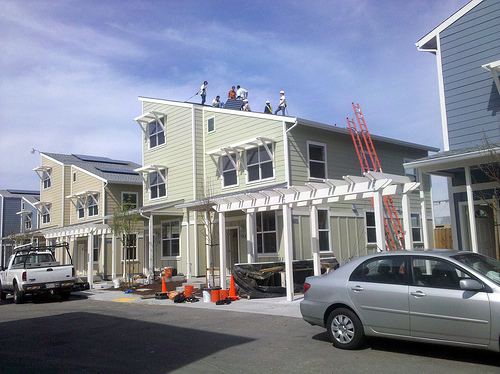Code Green Solutions


Green homes being constructed in Oakland, California
Do single-family homes with a green label command a market premium compared to a comparable home without the label? In California, the answer appears to be “yes”. A study, The Value of Green Labels in the California Housing Market, conducted by Matthew E. Kahn, a professor at UCLA and Nils Kok, a visiting scholar at UC Berkley and an associate professor at Maastricht University in the Netherlands, found that single-family homes with a green label sold for 8.7% more than other comparable homes without certification. Considering that the average transaction price of a non-labeled home in California equals $400,000, the price premium of 8.7% for a home with a green label translates into an incremental value of $34,800.
The researchers analyzed a sample of 4,231 buildings certified under Energy Star, LEED for Homes, or GreenPoint, and a control sample of 1.6 million single-family homes sold in California between 2007 and 2012. To isolate the impact of green home labels on the sales price, the researchers employed “hedonic pricing analysis” and controlled for such factors as geographic location, dwelling size, vintage, and the presence of amenities. The green homes in the sample were built by large US homebuilders, and were not considered high-end or customized. It is the first study to provide statistical evidence of energy efficiency and other sustainability measures being capitalized in sales prices of single-family homes with a green label.
The market premium associated with a green-labeled home significantly surpasses the input cost for the developer associated with energy efficiency measures. The developer will spend $10,000, at most, to reach a modeled energy efficiency level of 35% above California’s 2008 energy code for a typical 2,000 sq.ft. home. Moreover, 1/3 of those costs can be offset by rebates.
Will the price premium for energy efficient and sustainable homes be similar across various regions of California? The study found that the hotter the climate the greater the price premium for a green-labeled home. Moreover, using registrations of hybrid vehicles as a proxy for the environmental ideology of a neighborhood, the study found that green-labeled homes located in neighborhoods with a higher rate of registration of hybrid vehicles enjoyed higher sales prices.
By showcasing that single-family homes with a green label sell for higher prices compared to comparable homes without certification, this study may drive the development of more energy efficient single-family building stock. There are also implications for policy makers. Energy consumption data is currently available only for those homes that are eager to disclose this data voluntarily, more likely because of their exemplary performance. Mandatory disclosure requirement for all single-family homes could improve homeowners’ understanding of the energy efficient attributes of their homes, which, in turn, may reduce information asymmetry and increase adoption rates of energy efficient measures.